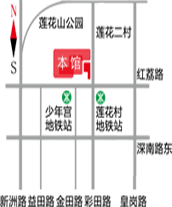
- Calligraphy and Imagery: A Brief Discussion on Ding Guanjia's Calligraphy
-
Calligraphy and Imagery
——A Brief Discussion on Ding Guanjia's Calligraphy
Zheng Weiren
Calligraphy and Chinese painting have an inseparable relationship. The origin of Chinese characters evolved from graphics and is the only pictographic script still in use today. In the process of the development of Chinese characters, a unique artistic form called calligraphy has gradually formed, with Chinese characters as the object of expression. During the Song Dynasty, literati painting emerged, and the use of calligraphy in painting became the most important characteristic of literati painting. Zhao Mengfu, a Yuan Dynasty poet, wrote a poem that goes, "Stones are like flying white wood, and bamboo requires eight techniques to be mastered. If someone else can master this, they will know that calligraphy and painting are the same." Dong Qichang of the Ming Dynasty said, "When literati paint, they should use the method of using the unique characters of grass and clerical script. Trees are like bent iron, mountains are like painting sand, and cutting off the sweet and vulgar path is to boost morale. However, even if they pass the exam, they have fallen into the realm of painting masters and are no longer salvageable. If they can break free from the rope, it is like penetrating the net scales." Most ancient literati and painters were also calligraphers, especially by the mid to late Ming Dynasty, cursive script had a great development. The artistic reconstruction of the form and structure of Chinese characters by cursive script gradually freed calligraphy from practicality and presented a vivid state of life, such as Xu Wei, Chen Chun, Ba Da, Shi Tao, Yangzhou Ba Guai, and even Wu Changshuo Qi Baishi and Huang Binhong were able to achieve such heights in their art precisely because they incorporated their calligraphy into their paintings, blending both calligraphy and painting. Emphasizing calligraphy has become an extremely important tradition among Chinese painters, and it is also the difference between literati painting and artisan painting.
Mr. Ding Guanjia is such an excellent artist who is skilled in both calligraphy and painting. His landscape paintings have a broad artistic conception, with brushstrokes and ink that follow nature and emotions, condensed and aged. He also has unique features in the use of colors, blending color and ink, and possessing a poetic humanistic atmosphere. After retiring from the position of director of Zhenjiang Art Academy, he moved to Beijing and successfully held a personal art exhibition called "Colored Ink Heart" at the China Art Museum, receiving high praise from the art community. But he did not retire and enjoy his old age peacefully. You never feel that he is almost an old man when you come into contact with him. He plays Weibo like young people and is curious about everything. He became interested in the common characters on the streets and alleys, as well as the childlike calligraphy of children. Many people are unaware that Ding Guanjia also has profound expertise in the art of calligraphy. During his youth, he studied at Nanjing Normal University under the tutelage of Fu Baoshi, Lv Sibai, Chen Zhifo, Yang Jianhou, Yaming, and Luo Zhizi. All of these emphasized the importance of calligraphy in Chinese painting and even Chinese culture, which had a profound impact on him. While creating his paintings, Ding Guanjia has always adhered to the study and exploration of calligraphy. He started with Yan Zhenqing, followed by Yang Ning's style and the works of the Two Kings, and delved deeper into the inscriptions of the Zhong Ding stele, drawing on various wonders. But he is not satisfied with "collecting ancient characters". For a painter, it is not difficult to imitate a certain post, but to form his own unique book style, it requires extraordinary exploration courage. Due to an artist's unique sensitivity to the aesthetic taste of Chinese character writing, Ding Guanjia found a unique flavor different from the general public's aesthetics in these unconventional folk characters and children's books. He cleverly extracted the interesting elements from them and integrated them into his own pen, gradually presenting his calligraphy with a unique and witty appearance that is like a monument, not a monument, but a post, not a post. His simplicity and generosity come from Duke Yan Lu, while his composure and ups and downs come from Lin Sanzhi. Influenced by Mr. Zhu Jialao, he particularly admires Fu Shan's "Four Nings and Four Wus" aesthetic concept and has been practicing it in calligraphy creation. Not being influenced by the times is very valuable for artists. His oracle bone script calligraphy is not limited to expressing knife carving, but utilizes oracle bone script to present changes in lines and the charm of ink and wash; His cursive script lacks the flaunting of techniques, the reckless waving, and is neither aggressive nor sharp, it is the rhythm of natural life. The commonality of a painter's calligraphy lies in that calligraphy should not only be a reproduction of ancient techniques, but should also be used as a carrier to bring life and personality to the extreme, such as the lacquer calligraphy of Jinnong in the Eight Strange Villages of Yangzhou, Zheng Xie's six and a half books, such as Qi Baishi, Li Keran, and so on. Ding Guanjia is the same. Their book style is highly recognizable and has a strong visual impact. Can the exploration path of painters in the current trend of calligraphy convergence, guided by exhibition effects, be worth learning from.
Mr. Li Kuchan once said, "The height of calligraphy is painting, and the ultimate of painting is calligraphy." From the perspective of both calligraphy and painting, Ding Guanjia can be said to have reached this height and achieved this ultimate.



